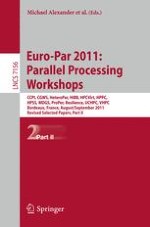2012 | Book
Euro-Par 2011: Parallel Processing Workshops
CCPI, CGWS, HeteroPar, HiBB, HPCVirt, HPPC, HPSS, MDGS, ProPer, Resilience, UCHPC, VHPC, Bordeaux, France, August 29 – September 2, 2011, Revised Selected Papers, Part II
Editors: Michael Alexander, Pasqua D’Ambra, Adam Belloum, George Bosilca, Mario Cannataro, Marco Danelutto, Beniamino Di Martino, Michael Gerndt, Emmanuel Jeannot, Raymond Namyst, Jean Roman, Stephen L. Scott, Jesper Larsson Traff, Geoffroy Vallée, Josef Weidendorfer
Publisher: Springer Berlin Heidelberg
Book Series : Lecture Notes in Computer Science
